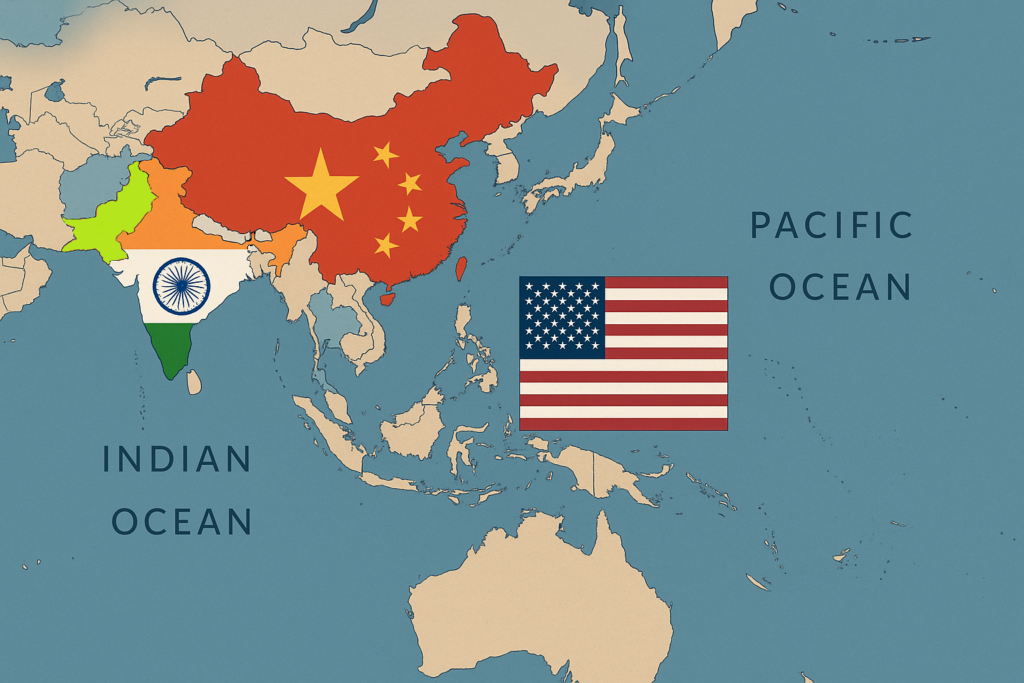
- The US-China agreement represents a temporary easing of tensions rather than a strategic reset.
- If the Indo-Pacific begins to doubt U.S. reliability, then China will undoubtedly fill the space.
- For India, this is a very crucial time to establish a firm voice in rapidly changing global politics.
- If India fails to build its internal capacity to navigate effectively in a rapidly changing world, it will face increasing difficulties externally.
Global Ripples of the U.S.-China Meeting
The recent meeting between US President Donald Trump and Chinese President Xi Jinping on the sidelines of the Asia-Pacific Economic Cooperation (APEC) summit in South Korea marked a notable moment in US-China economic and strategic relations. The two countries agreed on a partial reduction of US tariffs on selected Chinese goods, while China committed to pausing newly announced export controls on certain rare earths and critical minerals for a limited period. In addition, the summit produced the Gyeongju declaration (2025) by APEC leaders, which emphasised digital transformation, artificial intelligence governance and inclusive growth.
President Trump described the meeting as “12 out of 10” and even suggested a “G-2” framing of US-China Cooperation. The agreement represents a temporary easing of tensions rather than a strategic reset. For India and the broader Indo-Pacific, the implications are significant. The deal signals that US-China Trade competition is entering a new phase, with a ripple effect along the global supply chains, tariff regimes, and the balance of strategic influence.
The entire Trump tariff policy to “Make America Great Again” is under question, but it has definitely given space for China to grow. This meeting further positioned China’s global power and its increasing domination.
China Filling the Strategic Vacuum in Asia
Trump also left the ASEAN summit early, and many nations affected by U.S. tariff policies have seen China fill that vacuum. Thailand was hit hard by tariffs and has no option but to look toward China. Similarly, Australia, despite being close to the U.S., has appointed its national intelligence officer, a dove, replacing a hawk. Other ASEAN nations also lack strong trust in the U.S. and are now looking to China for hope regarding its South China Sea policy.
If the Indo-Pacific begins to doubt U.S. reliability, then China will undoubtedly fill the space. This was demonstrated by Xi Jinping, who told the Communist Party’s Central Committee in early October that China must “seize the window of opportunity to consolidate and expand our strengths, break past bottlenecks and surmount weaknesses, to gain the strategic initiative in intense international competition.
India’s Watchful Eye on the U.S.-China Equation
For India, this U.S.-China meeting is being closely observed, as India remains among the most affected countries by U.S. tariff policies, including an extra 25% on purchasing Russian oil despite China doing the same. Not only this, but the H1B visa fee hike, the U.S.’s tolerant stance towards Pakistan during Operation Sindoor, and the recent issue of U.S. sanctions on India’s Chabahar Port in Iran are also concerning developments.
Growing Chinese Influence in India’s Neighbourhood
The rise of Chinese diplomacy in India’s neighbourhood is clearly visible — China supporting Pakistan during Operation Sindoor, the China-Pakistan Economic Corridor (CPEC), and the Bangladesh-Pakistan defence engagements backed by China. During a recent visit to Pakistan, Bangladesh even presented a Bangladeshi map that showed parts of Indian territory as Bangladeshi. Myanmar, too, has earlier strengthened its close ties with China. Altogether, China’s influence and dominance in India’s surrounding region are increasingly evident.
India’s Diplomatic Outreach and Global Engagements
For India, this is a very crucial time to establish a firm voice in rapidly changing global politics. India is indeed making efforts and diversifying its policy, but the pace is not yet comparable to China. The UK-India trade deal, the ongoing EU-India FTA talks, and India’s call for unity and protection of sovereignty at ASEAN regarding the South China Sea are steps in that direction. Similarly, India’s major exchanges with Afghanistan, along with its growing engagements with Armenia, Peru, Chile, and others, reflect important diplomatic outreach.
Balancing Between the U.S. and China
At the same time, India must balance its policy between the U.S. and China — resolving differences, strengthening relations based on shared interests, and consolidating partnerships for global and economic diversification. However, to demonstrate strong friendship and leadership, India must first have something concrete to offer.
Building Domestic Strength for Global Leadership
For that, India has to heavily invest and work domestically — through economic and technological reforms, defence modernisation, and investment in education and skill development. The focus should be not just on producing engineers but also on building institutions that nurture scientists and promote research and development. Strengthening institutions and maintaining a proactive diplomatic approach are essential.
If India fails to build its internal capacity to navigate effectively in a rapidly changing world, it will face increasing difficulties externally.
References:
- https://lkyspp.nus.edu.sg/cag/publications/center-publications/publication-article/detail/india-china-us–a-triangle-of-apprehension
- https://www.cfr.org/backgrounder/contentious-us-china-trade-relationship#chapter-title-0-2
- https://www.cfr.org/blog/trump-and-xi-turn-back-clock-while-china-flexes-its-muscles
- https://frontline.thehindu.com/news/india-defence-autonomy-trump-indo-pacific-strategy-2025-shift/article70221027.ece
Garima Sharma is a Master’s student in International Relations at Jawaharlal Nehru University. Her interests include public policy, international governance, geopolitics, defence, and security. Views expressed are the author’s own.
